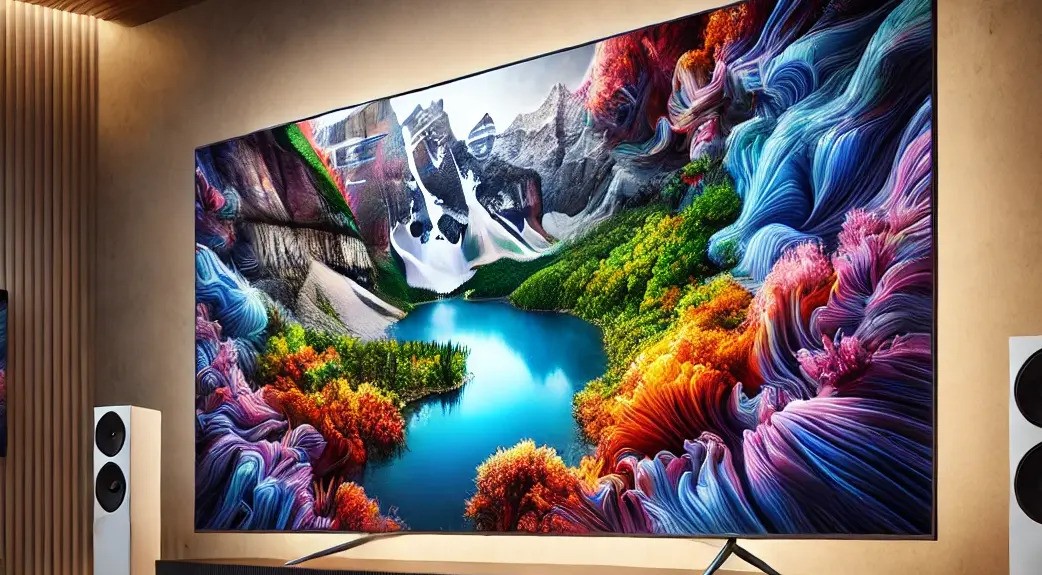1. Introduction
In the world of high-definition televisions, 5K resolution represents a significant leap forward. With more pixels than 4K and Full HD, a 5K TV provides stunning image clarity and a richer viewing experience. But is it worth the investment? This guide will explore the features of 5K resolution, compare it with other popular display technologies, and help you understand when it might be the right choice for you.
If you’re unsure about TV resolutions, you can learn more about the basics of good TV resolution in our previous article here.
2. What is 5K Resolution?
5K resolution refers to a display with approximately 5,000 pixels across the horizontal axis, providing a total pixel count of around 14.7 million. This means the image on a 5K display is incredibly sharp, with finer detail than Full HD or even 4K displays. The increased pixel density of a 5K screen ensures that the image remains crisp, even when viewed from a closer distance.
For tech enthusiasts, the high pixel density of 5K displays offers a more immersive viewing experience, especially on larger screens. This enhanced clarity is particularly noticeable in high-definition content like 4K movies and gaming, where every pixel counts in creating lifelike images.
3. 5K vs. Other Resolutions
5K vs. Full HD
Full HD displays have 1080 pixels in the horizontal dimension, which is significantly fewer than the 5K resolution. This lower pixel count means Full HD TVs are unable to reproduce the same level of fine details and vibrant colors that a 5K TV can. The difference becomes especially noticeable on larger screens or when sitting closer to the TV.
5K vs. 4K Displays
While 4K displays offer a resolution of around 8.3 million pixels, a 5K display has more pixels (14.7 million), leading to an even sharper and more detailed image. However, the visual difference between 5K and 4K may not be immediately obvious unless you’re viewing very high-quality content or using the TV for professional work such as video editing or graphic design.
5K vs. 8K
8K displays offer a much higher resolution (around 33 million pixels), but 5K is often a sweet spot for most consumers. While 8K provides exceptional detail, the human eye may struggle to distinguish the additional pixels unless you’re sitting extremely close to the screen. Therefore, for many, a 5K resolution strikes the perfect balance of performance and practicality.
4. Benefits of 5K Displays
There are several reasons why 5K displays are gaining traction in the tech world:
- Sharper Image Quality: The increased pixel density means more detailed visuals and less visible pixelation, resulting in clearer and more immersive viewing.
- Enhanced Color Accuracy: 5K displays typically support a wider color gamut, offering more accurate colors and lifelike images, making them ideal for professional photo editing, video production, and content creation.
- Multitasking Efficiency: Larger 5K displays provide more screen real estate, which is perfect for multitasking or professional use. Whether you’re editing videos, working on large spreadsheets, or designing graphics, the additional space can improve productivity.
5. Who Should Buy a 5K Resolution TV?
5K TVs are ideal for those looking for an ultra-clear viewing experience. They’re particularly beneficial for:
- Gamers: For gamers who want the sharpest visuals possible, a 5K TV offers a significant upgrade over 4K, providing crisp details even in fast-paced games.
- Professional Creators: If you’re in photography, video editing, or graphic design, the higher pixel density and enhanced color accuracy of a 5K TV can help with precision work.
- Movie Enthusiasts: A 5K TV is perfect for those who want to experience movies in the highest possible detail. Whether you’re watching 4K content or streaming from your favorite service, the clarity will be exceptional.

6. Popular 5K Resolution TV Models
There are several 5K TV models on the market, each offering different features and specifications. Some of the most notable models include:
- Apple Pro Display XDR: Known for its exceptional image quality and color accuracy, ideal for professional use.
- LG UltraFine 5K: A favorite among creatives for its stunning display and integration with Mac devices.
- Dell UltraSharp 32 Ultra HD 5K Monitor: A great option for professionals looking for a high-resolution monitor for work purposes.
7. Things to Consider Before Buying
Before purchasing a 5K TV, there are a few factors to keep in mind:
- Screen Size: 5K displays are usually best enjoyed on larger screens (27 inches and above), as their higher resolution is more noticeable on bigger displays.
- Viewing Distance: You’ll want to sit closer to a 5K TV for the full experience. Sitting too far away may diminish the clarity of the image.
- HDR and Refresh Rate: Consider additional features like HDR support for richer contrast and faster refresh rates for smoother motion during gaming or sports viewing.
- Smart TV Features: Ensure the TV has the right connectivity options and supports the streaming services you use.
8. Future of 5K Displays
As technology advances, we can expect 5K displays to become even more common. With more content being shot in 4K or higher, having a 5K display will only improve the viewing experience. Additionally, future models are likely to support better HDR, faster refresh rates, and improved smart features, ensuring that 5K TVs remain relevant in the coming years.
9. Conclusion
In summary, 5K resolution TVs offer superior image quality, making them ideal for professionals, gamers, and anyone looking for an immersive viewing experience. While not necessary for everyone, they do provide a noticeable improvement in pixel density and color accuracy over Full HD and 4K models.
Ultimately, if you’re looking to future-proof your entertainment setup and enjoy the sharpest visuals, a 5K display might be the right choice.
